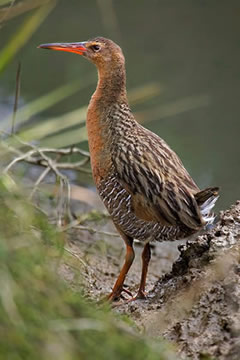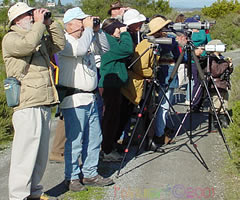
Field Trip Ethics
Protect Birds

Ridgway’s Rail. Photo by Richard Bohnet.
Be quiet and do not approach birds too closely. Try to observe the birds so they are unaware of your presence, and don’t disrupt their normal activities. Avoid quick movements and discordant noises.
In particular, observe nesting birds from a distance that will avoid disturbing them. If parents become alert to your presence, retreat quietly and leave. Approaching a nest too closely may cause parents to abandon eggs or young completely or temporarily, exposing the nest to predators. Do not handle or otherwise disturb eggs or young.
Recorded bird sounds shall not be used. This includes any kind of playback from digital devices all year round.
Keep motor vehicles on established roads and parking areas. One set of tracks invites others. In fragile ecosystems tracks may last for many years, and degrade and destroy habitat.
Obtain permission for entry to private lands, and when necessary to government lands. Respect the owner’s privacy and property. Don’t block access ways and leave gates as you find them.
In fragile areas, walk single file or spread out or whatever method causes the least damage.
Do not leave litter. Do not smoke.
Revised May 7, 2019
Consideration for People

Keep talk, noise and disturbance to a minimum so that everyone in the group can hear the birdsongs, other natural sounds, and instruction from leaders.
Be friendly and welcome newcomers to the group. Avoid gathering in cliques.
Be respectful and considerate of other participants.
If a confrontation or other unpleasant interaction occurs, the leader should intercede in a non-judgmental way to separate people involved and/or attempt to calm the situation.
Put the interests of the group before your own. Keep the birding group together so that all individuals in the group can share interesting and unusual sightings.
When in a group with mixed birding abilities, the leader or better birders should assist others in identifying birds and pointing out field marks, habitats and ecological relationships.
Drive lawfully, use common sense and be considerate of other birders. If stopping along a road, leave enough space for cars to pass; do not stop on blind curves.
Enjoy yourselves!
Approved by the Board November 8, 2016